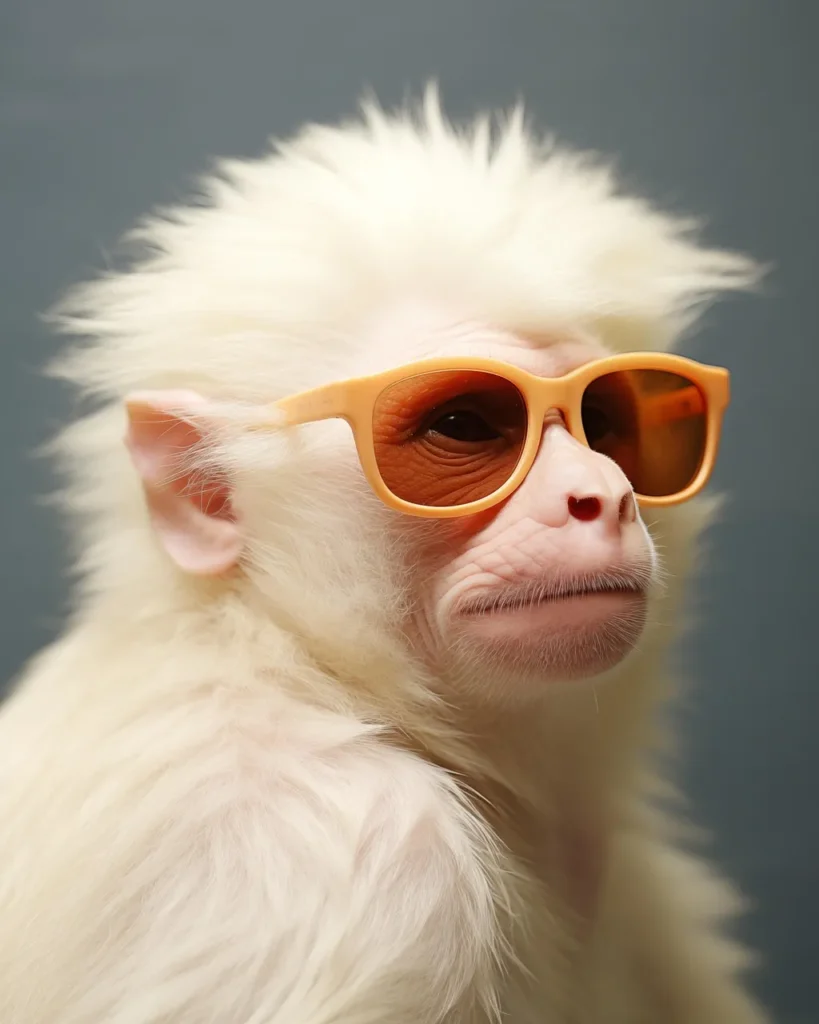While their striking appearance makes them a rare and fascinating sight, albino monkeys face significant health and survival challenges due to their genetic condition. The absence of melanin, a pigment vital for more than just coloration, impacts their vision, skin, and overall ability to thrive. This article explores the specific health problems that afflict albino monkeys and the unique difficulties they encounter in both the wild and in captivity.

The Role of Melanin: More Than Just Color
To understand the health problems of an albino monkey, you first need to understand the role of melanin. This pigment is responsible for the color of skin, hair, and eyes, but its function extends far beyond mere appearance. Melanin protects the skin from the sun’s harmful ultraviolet (UV) radiation and is also essential for the proper development and function of the eyes and nervous system. In albino monkeys, a genetic mutation prevents their bodies from producing this vital pigment. This deficiency leads to a host of health issues.
Health Problems Associated with Albinism
The most notable health problems in albino monkeys are related to their lack of pigmentation. These issues are often chronic and can severely impact their quality of life.
Vision Impairment
One of the most serious consequences of albinism is its effect on the eyes. Melanin is a crucial component in the development of the retina, the optic nerve, and the iris. Without it, albino monkeys can suffer from a range of irreversible vision problems, including:
- Photophobia: Extreme sensitivity to light, causing them to squint and seek shade.
- Nystagmus: Rapid, involuntary eye movements that make it difficult to focus.
- Poor Visual Acuity: Their vision is often blurry, and they may struggle with depth perception.
- Astigmatism: An irregularly shaped cornea or lens that causes blurred vision.
These vision issues put albino monkeys at a significant disadvantage when foraging for food, navigating their environment, or detecting predators.
Skin and Sun Vulnerability
Since melanin also acts as a natural sunscreen, albino monkeys are highly susceptible to the damaging effects of the sun. Their pale skin, which lacks protective pigment, is prone to severe sunburn and can lead to a heightened risk of developing skin cancer and other dermal ailments. This vulnerability can be a constant threat, particularly for those living in sunny, tropical habitats.
Survival Challenges in the Wild
For an albino monkey, life in the wild is extremely difficult and often short. Their health problems, combined with a striking appearance that makes them stand out, create a dangerous existence.
Increased Predation Risk
Normal monkeys rely on their natural coloration to provide camouflage, helping them blend in with the leaves and branches of their environment. An albino monkey, with its stark white fur, is easily spotted by predators from both the ground and the air, making it an easy target. This lack of natural camouflage is perhaps the greatest threat to their survival.
Social and Behavioral Issues
The unusual appearance of an albino monkey can also impact its social interactions within its troop. In some cases, albino animals may be ostracized or rejected by their peers due to their different appearance, which can lead to isolation and a lack of protection. While not universal, this social exclusion can further diminish their chances of survival and make it difficult for them to find a mate and pass on their genes.
Life in Captivity: A Safer Alternative?
Given the significant challenges they face in the wild, albino monkeys often have a better chance of survival in a controlled environment like a zoo or sanctuary. In captivity, they can receive specialized care that mitigates their health problems.
- Veterinary Care: They can be treated for any skin issues or vision problems.
- Sun Protection: Caretakers can provide them with access to shaded enclosures and may even apply special sunblock.
- Shelter: They are safe from predators and social rejection, allowing them to live longer and healthier lives.
While captivity provides a safer environment, it’s a trade-off. It allows for their survival and study but removes them from their natural habitat and social structures. The rarity of albino monkeys in the wild underscores the severity of the challenges they face, making them a poignant reminder of the vital role that genetics and natural selection play in the animal kingdom.
Frequently Asked Questions
Q: What is albinism? A: Albinism is a genetic condition characterized by a lack of melanin, a pigment that gives color to hair, skin, and eyes. It affects many species, including monkeys.
Q: Do albino monkeys have poor eyesight? A: Yes, vision problems are a major health issue for albino monkeys. Without melanin in their eyes, they often suffer from photophobia (light sensitivity), blurry vision, and involuntary eye movements.
Q: Why are albino monkeys so vulnerable to the sun? A: Melanin acts as a natural sunscreen. Since albino monkeys lack this pigment, their skin is highly sensitive to the sun’s UV rays, making them prone to severe sunburn and a higher risk of skin cancer.
Q: Are albino monkeys rejected by their groups in the wild? A: The social dynamic varies. In some cases, their unusual appearance can lead to social isolation or rejection, which further endangers them in the wild.
Q: Can albino monkeys survive in the wild? A: Survival in the wild is very difficult. Their lack of camouflage makes them easy targets for predators, and their health issues, particularly poor vision, hinder their ability to find food and navigate safely.
Q: Are albino monkeys healthier in captivity? A: Generally, yes. In zoos or sanctuaries, they receive specialized care, including protection from predators and the sun, proper veterinary attention, and a consistent food supply. This significantly improves their chances of living a longer, healthier life.
